How eight25 Reshaped Qlik’s Multi-Brand Web Presence
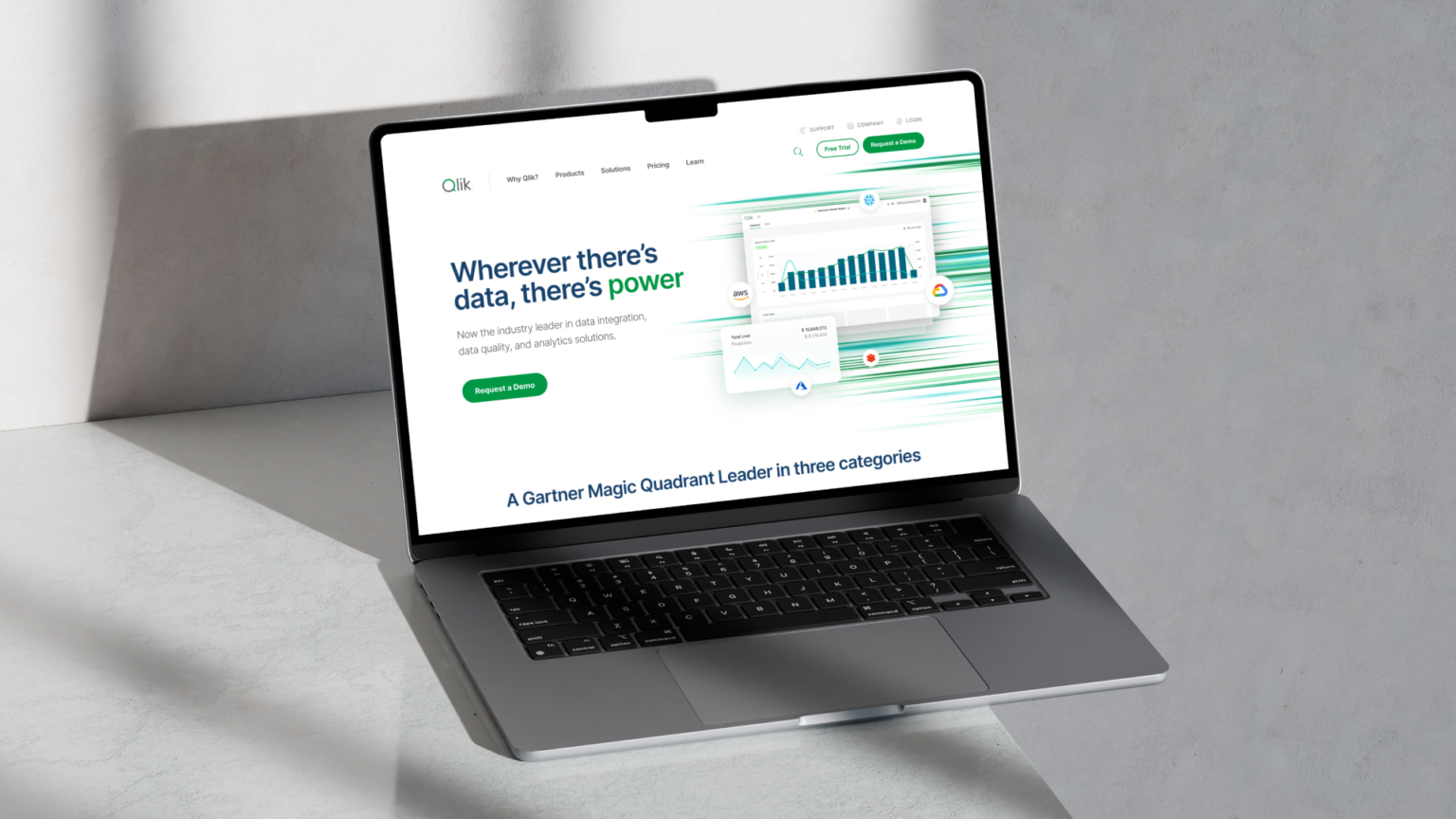
About the company
- Company Name: Qlik
- Headquarters: PA, USA
- Industry: Data Integration, Analytics, and AI
- Company size: 2000+ Employees
- Customers: 40,000+
Introduction
Qlik aimed to revitalize its brand while expanding its footprint in analytics and data integration. The recent acquisition of Talend presented a prime opportunity to support this vision.
Qlik planned to leverage this and transform its website into:
- a dynamic platform that drives revenue,
- reflects its new market position,
- and offer a best-in-class user experience.
Challenges
- Outdated Brand Identity and Inconsistent Web Presence
- The website’s outdated brand identity failed to reflect the modern, innovative, and SaaS leadership image they needed to demonstrate their relevance in the industry.
- The website no longer showcased the new value proposition and capabilities resulting from its recent acquisition.
- Visitors struggled to quickly and clearly understand the brand and its offerings.
- Disconnected Navigation Menu and a Complicated User Journey
- The website faced a major challenge with poor user experience. It was confusing and difficult to navigate, leaving users unsure of where they were or where to go next. The content was hard to read and follow, making it tough for visitors to find the information they needed.
- Publishing Delays Held Back Marketing Agility
- The CMS platform lacked the flexibility needed for seamless content publishing and updates. Every change required developer assistance, making it difficult to keep up with the fast-paced demands of modern marketing.
How eight25 helped Qlik?
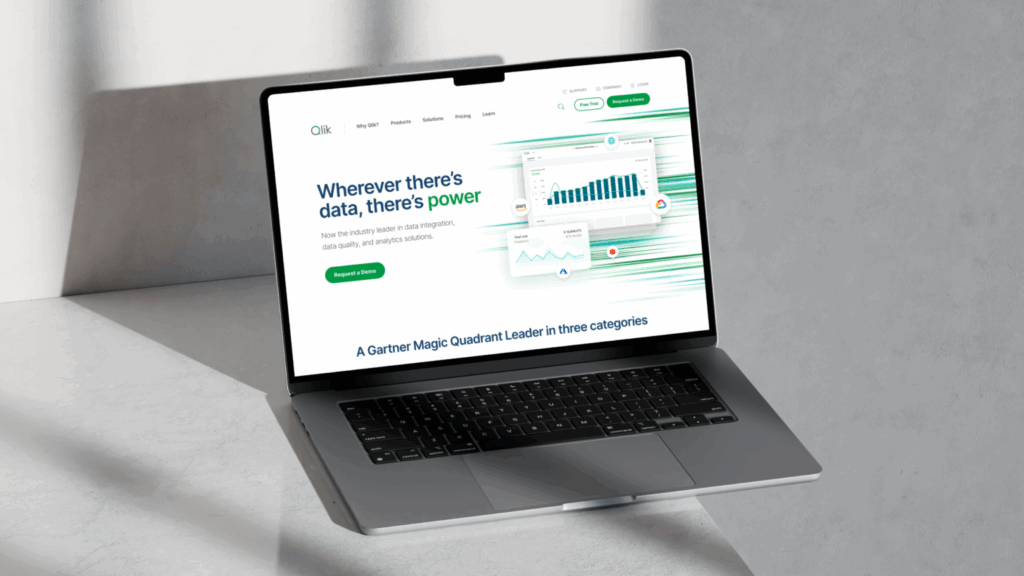
1. Brand Refresh
After acquiring Talend, Qlik was poised to broaden its influence in the analytics and data integration markets. While Qlik had long been recognized as a Gartner magic quadrant leader in analytics, the addition of Talend’s capabilities allowed the company to extend its reach into the data integration space.
To reflect this new market position, eight25 helped in transforming the site into a cohesive brand vehicle, seamlessly integrating the identities of both Qlik and Talend while maintaining a unified and compelling digital presence.
Here’s how we approached the process:
- First, we assessed whether the software products shared similar characteristics.
- For instance, both products had very different visual characteristics.
- Data analytics Product – Highly visual
- Data Integration product – Was more backend-oriented and harder to visualize
- Next, we determined if the products were targeted to the same buyer persona.
- For example, was the software purchased by both technical and non-technical buyers?
- Did it appeal to decision-makers as well as end-users?
- Finally, we evaluated the technical complexity of each product.
- A technical product might require detailed platform graphics.
- A non-technical product may need less detailed content.
Given that Qlik and Talend’s products:
- Didn’t look or feel the same,
- Appealed to different types of customers,
- And varied in technical complexity,
We built two separate web experiences.
Here’s how eight25 implemented this:
- Separate Components and Templates:
eight25 customized each product’s web presence with tailored templates and components, highlighting their unique strengths and catering to their specific audiences.
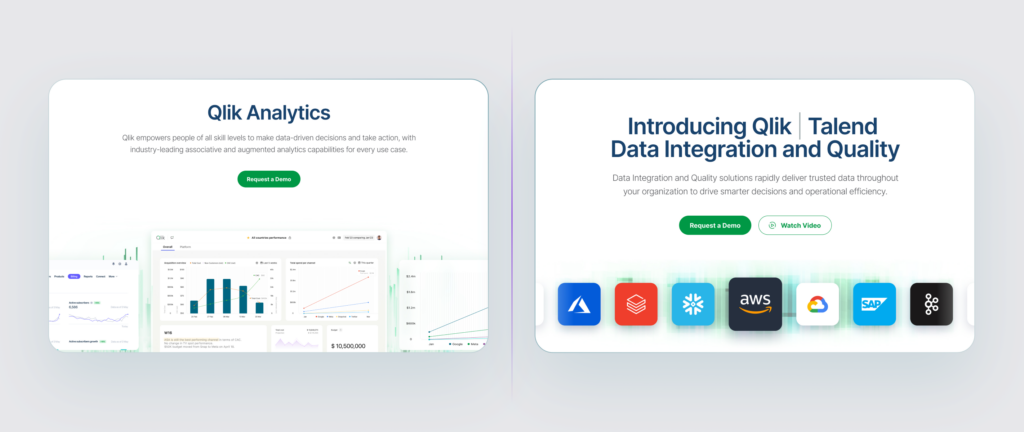
2. User Experience
The recent acquisition made it crucial for the website to guide two diverse audiences to the right product pages.
The main issues were:
- Users seeking their Data Analytics Product weren’t interested in their Data Integration Product.
- Navigation links directed everyone to the same unified pages.
- Visitors landed on identical pages, regardless of their interests.
So, how did we simplify navigation?
Here’s what we did:
- Distinct Tabs:
- Created separate tabs for Data Analytics Product and Data Integration Product
- Tailored each tab to its specific audience.
- Enabled visitors to easily find the product they were interested in.
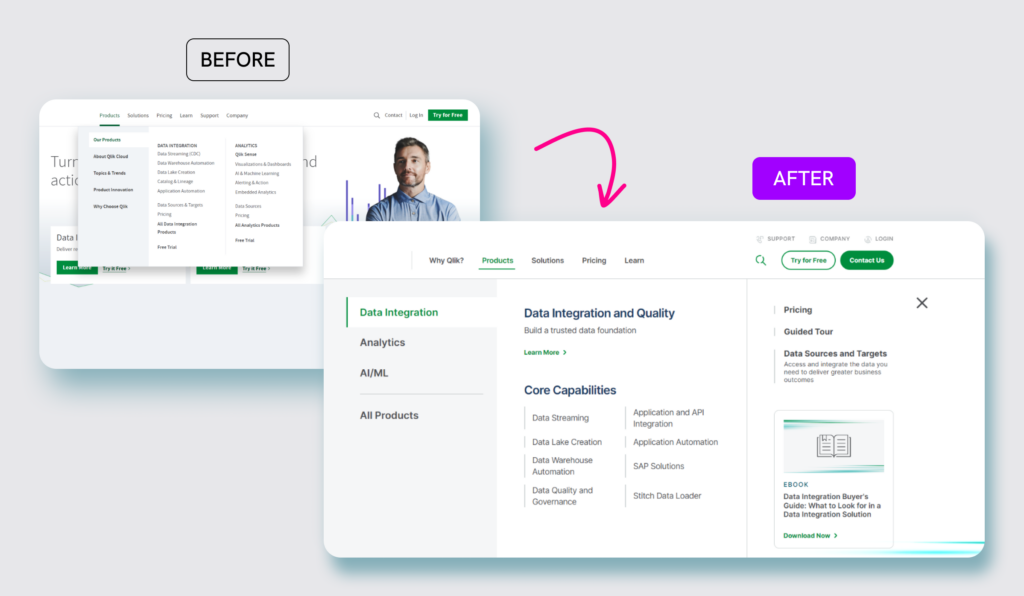
- Effective Use of Space:
- Focused on presenting the most important options
- Reduced the number of navigation links.
- Minimized cognitive overload to simplify navigation.

- Intuitive Organization:
- Organized product tabs in a logical order.
- Provided a clear product overview.
- Linked relevant capabilities and shared useful resources.
Streamlining User Navigation for Qlik’s Two Diverse Product Offerings
With two distinct products catering to different audiences, Qlik faced challenges in guiding users to the right products, solutions, and capabilities, making it difficult for them to easily find the information they needed.
eight25 addressed this by deliberately focusing on prioritizing user needs and employing clear design principles to logically group products.
This intuitive and responsive setup made exploring diverse product offerings easy, minimized unnecessary clicks, and ensured that key navigation options remained easily accessible.
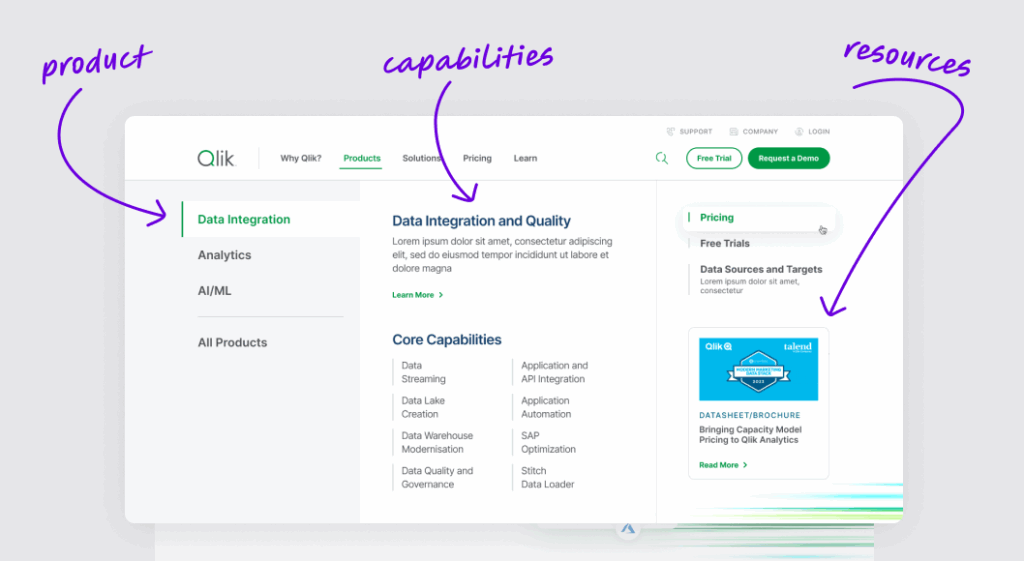
To organize navigation intuitively for users, we:
- Prioritizing User Needs: We identified the most important tasks users want to accomplish and made those features easily accessible on the site.
- Using Clear Labels: We ensured that navigation labels were straightforward and accurately reflected the content or actions users would find.
3. Replatforming
To address the limitations of their outdated CMS platform, we helped Qlik with re-platforming their website and migrating Qlik’s content from Sitecore to Contentful CMS.
This transition was crucial for modernizing their content management capabilities and enhancing overall website performance.
Here’s what we did
- Migration to Contentful: We meticulously transferred Qlik’s content from Sitecore to Contentful. This shift to a headless CMS allowed for greater flexibility and efficiency in managing and delivering content.
- Introduction of Reusable Components: We introduced modular, adaptable components to streamline content creation, making it easier and faster to build and update pages.
- Development of a Design System: We developed a comprehensive design system with templates and guidelines, ensuring consistent and scalable visual design across all pages.
- 353 Pages Coded and Built
- 128 Components Developed
- 2734 Secondary Pages Migrated
- 37 Wireframes
- 53 Templates Designed
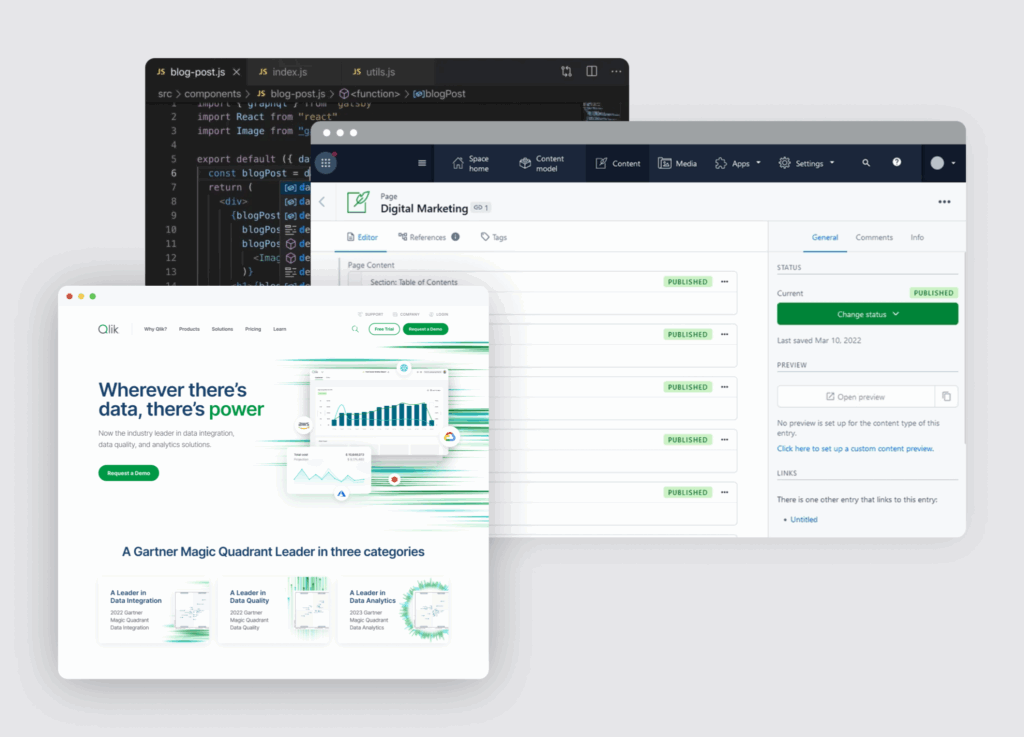
Technology Stack
- Contentful
- Netlify,
- Cloudinary
- Next.js
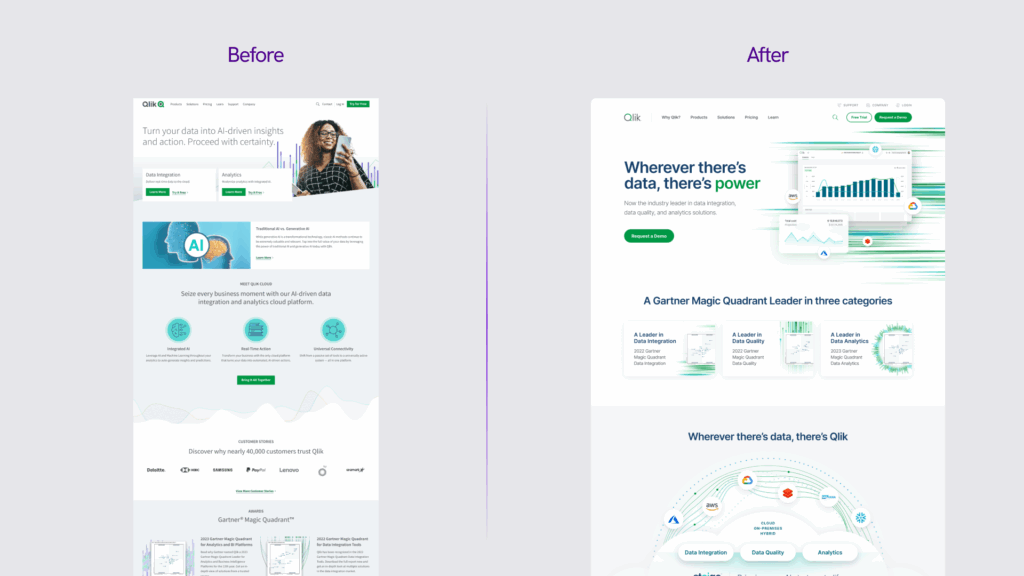
Key Results and Benefits
- Accelerated Launch Timeline: 191 days to launch.
- 353 Pages Coded and Built
- 128 Components Developed
- 2734 Secondary Pages Migrated
- 37 Wireframes
- 53 Templates Designed
- Customized Web Presence: eight25 tailored each product’s web presence with custom templates and components.
- Improved Conversions: Enhanced user experience and targeted design led to increased conversions.
- Streamlined Content Creation: Created reusable components that simplified content creation, making it faster and easier to build and update pages.
- Increased Flexibility and Efficiency: The migration to headless CMS provided greater flexibility and efficiency in managing and delivering content.
- Optimized User Navigation: Streamlined navigation for Qlik’s diverse product offerings, ensuring users could easily find relevant information.